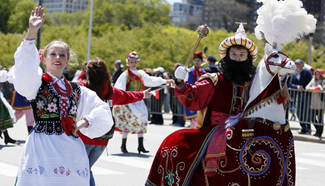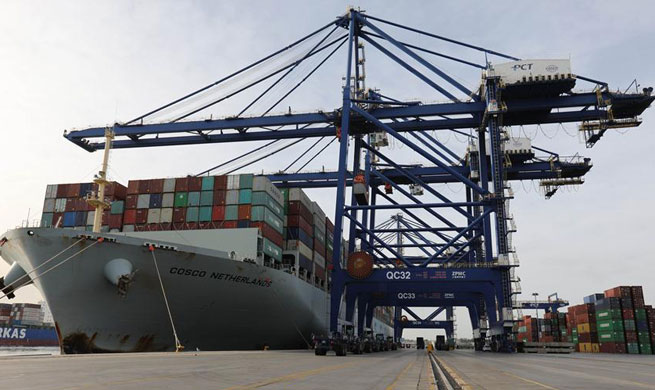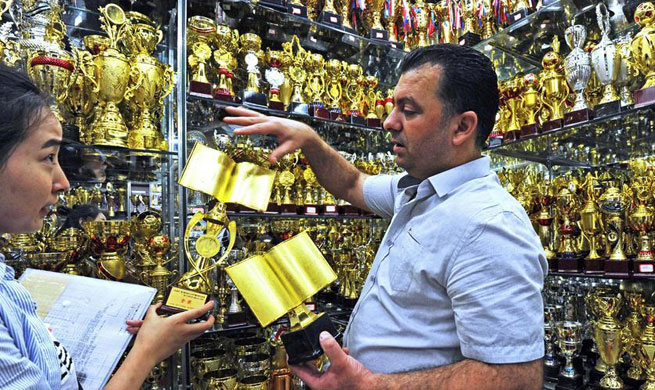by Xinhua writers Ma Qian, Chen Yin
BEIJING, May 8 (Xinhua) -- Bai Ying is the Chinese name of Tamara Bernal, an Ecuadoran student in China. The 26-year-old girl has been studying Spanish-to-Chinese translation and interpretation as a postgraduate.
As one of the four ancient civilizations, China has attracted with its profound traditional culture a great many foreign students to come to study and chase their Chinese dreams. Bai is one of them. Yet maybe she does not know that over 1,000 years ago, China was already a popular destination for overseas students.
"DELIGHT TO HAVE FRIENDS COME FROM AFAR"
The origin of the concept of foreign students is related to Japan. During the Sui and Tang Dynasties (AD 220-907), China, with developed economy and powerful national strength, was the economic, political and cultural center of Asia. Since the beginning of the Sui Dynasty, China started to welcome a large number of foreign students. During the Tang Dynasty, a host of foreign students were sent to China from countries including Japan, Annam, Goryeo, the Baekje Kingdom and the Silla Kingdom. Some also dispatched envoys and monks to study in China. Japan, in particular, sent the largest number of students to China at that time.
During that period, Japan was undergoing a key stage in reform and had sent, for many times, envoys to China to learn its systems, advanced cultures, as well as codes and books of the Sui and Tang Dynasties. Apart from envoys, also came to China were seamen, students, craftsmen and monks.
Among the Japanese monks studying in China, Abe no Nakamaro is worth mentioning. Born into a political family, he was smart, talented and studious as a child. In 717, Abe, less than 20 years old, was selected to study in China, owing to his excellent learning of the Chinese language. After he arrived at Chang'an, the then capital of China, he got special permission to study in the Imperial Academy, which was the highest educational institution. After years of assiduous study, the gifted Abe achieved jinshi in the Chinese imperial examinations, which was essential to candidacy for state officials.
With a Chinese name of Chao Heng, Abe was highly appreciated by the imperial court for his ability as well as outstanding literary performance. He was also an excellent poet. With a lot of research in poetry, he not only wrote poems, but also kept close contact with prominent poets like Li Bai and Wang Wei. In 770, Abe passed away in Chang'an. He was widely recognized by later generations for making contributions to spreading the civilization of the Tang Dynasty and promoting the friendship between China and Japan.
Except Abe, there were also other Japanese students that played an important role in enhancing Japan's development, exerting great influence on their country's politics, economy, language, religion among others. They also contributed to the spreading of the Tang culture.
LEARNING FROM FOREIGNERS TO DEFEAT THEM
During the mid-19th century, due to its closed-door policy, the Qing Dynasty failed to catch up with Western countries' fast development pace driven by the industrial revolution, and suffered from a series bitter, unforgettable national humiliation.
To resist the invasion by Western powers, a group of officials and scholars put forward the slogan of "learning from foreigners to defeat them." For them, it was imperative to recognize the fact that China had lagged behind and should learn the advanced technologies of the Western countries.
Despite fierce debates, the first batch of Chinese students dispatched by the imperial court arrived in the United States. From 1872 to 1875, the Qing government sent four batches of a total of 120 students to the United States, whose average age was around 12. So, the later generations also called them "children studying abroad."
After arriving in the United States, the students soon adapted themselves to American lifestyle.
Due to the obstruction of the conservative forces in the Qing government, the originally planned studying program of 15 years was canceled and all the Chinese students abroad were recalled. Back in their homeland, they suffered much sarcasm. However, such experiences did not frustrate them and they later became mainstays of different walks of life.
Among them, Zhan Tianyou was hailed as the "father of Chinese railroads." He was the chief engineer responsible for the construction of the Peking-Kalgan Railway, which is still in use today. Tang Shaoyi served as the first premier of the Republic of China in 1912. Tang Guoan became the first president of Tsinghua University in 1912. The other "children studying abroad" also showed their talents in various fields including diplomacy, telecommunications, education and mining industry, among others.
To some extent, these "children studying abroad" broke China's long-term closed-door policy, symbolizing the start of China's embrace of the world's development trend.
The reform and opening up launched in the 1970s sparked the second tide of studying abroad in China. Throngs of Chinese students went overseas to study the advanced technologies and concepts of the rest of the world. After their return, they became the backbone of the country's reform and opening up, and witnessed the growth of the "China economic miracle." At the beginning of the reform and opening up, many Chinese students abroad wondered that when China would catch up with those advanced countries. Now, more and more Chinese students studying abroad choose to return to their country, because China has a faster development pace.
STUDY IN CHINA & LEARN CHINESE ACROSS THE WORLD
Over the last three decades of reform and opening up, as China's national strength has been constantly increasing, more and more Chinese students wanted and did "go global." At the same time, China's economic potential and the unique charm of the traditional Chinese culture have attracted more and more foreign students to study in China.
In 2015, the number of Chinese students studying abroad reached 1.26 million, accounting for 25 percent of the world's students studying outside their countries. At the same time, 397,600 foreign students came to study in China, taking up 8 percent of the world's students studying outside their countries, according to the annual report on the development of Chinese students studying abroad (2016), published by Center for China and Globalization.
In recent years, there has been an upsurge in the number of foreign students learning Chinese. According to statistics from the Confucius Institute Headquarters, 512 Confucius Institutes have been established in 140 countries and regions by the end of 2016. A total of 1,073 Confucius Classroom programs have been launched, in which the Confucius Institute partnered with local secondary schools or school districts to provide teachers and teaching materials.
Since the Belt and Road Initiative was proposed in 2013, there was a surge once again in the number of foreign students studying in China. For many foreign students, the initiative, committed to common development and prosperity, has provided a platform for them to achieve their dreams.
To be a diplomat is Bai Ying's dream. The Ecuadoran student wants to contribute to tighter China-Ecuador ties. "If you want to be an excellent diplomat, you have to study the language and culture of related countries well," Bai said.
"China is a fast-developing country, and has been Ecuador's key trading partner. So, there are more and more Ecuadorans studying Chinese. If you learn Chinese, you will have lots of opportunities." (Chen Yao, Gao Chunyu also contributed to the story)


















